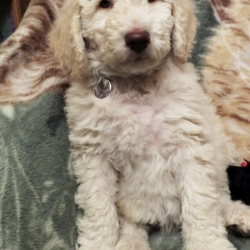


Preparing for your new puppy and your first day and week home….Â
When parents find out they are going to have a child they make all sorts of preparations. A room is set aside and possibly the walls are covered with an appropriate wallpaper or paint, a supply of formula fills the pantry, baby bottles and diapers are purchased in huge quantities, toys and pacifiers are picked out, the baby’s doctor is selected, etc. You need to make the same preparations for the puppy, and think about the supplies you will need, the car ride home, and the new puppy’s activities, feeding, and health care check-up.
Your puppy is going to need a room or at least a place he can call his own, and a cage or crate will fill this bill. You are better off getting one that is big enough for him to use as an adult.
I personally recommend a Pen and Crate setup, here are some good examples of how you can setup a useful containment system up for your puppy…
Your new puppy will need a puppy bed, 2 steel or ceramic bowls, toys to chew on and play with, a collar and leash and ID tag, a bag of a high quality dry (Grain Free) puppy food, small treats and a clicker for training, a large litter box or puppy pads. (I personally don’t like puppy pads but some people find them to be useful. I’ve found that puppies chew up puppy pads, drag them around and basically make a mess with them and I’ve never had any luck with the puppy pad holders either).
Please use the button below to visit our most recommended products for your new puppy! We’ve done all the testing for you! Priceless info!
The big day arrives, and it is off to pick up the new puppy. Coming home will start out with a car ride from the shelter or breeder’s home. Try to keep this from being an overly stressful experience for the pup. The main problem dogs have with car rides usually is not what we humans refer to as motion sickness, but simple anxiety about the vibrations, sounds, and to a lesser degree, the movement. Many dogs that have developed problems with car rides get nervous or even nauseous before the engine is even started. It is important that this first trip not be a bad experience that regresses into a repetitious behavioral pattern.
Before you head home with your new puppy, you should try to get the pup to go to the bathroom so there are no floods or surprises stimulated by all the excitement of the ride. On this first trip home, we break a cardinal rule about traveling with pets. We do not put them in a crate for traveling. Remember, they are small and easy to hold. Rather, we have someone other than the driver hold the puppy in a blanket or towel and talk or in some way try to distract him from the ride. If you have a long way to go and need to stop for the puppy to relieve himself, do not use a highway rest stop. At his young age, the puppy has very little, if any, protection from common dog diseases, and these areas can easily be contaminated with the organisms causing these conditions.
Leaving her mother and littermates will probably bring about some anxiety. However, this can be greatly diminished if you plan your schedules so that you will be home with the puppy the first 3 to 4 days. Some authors suggest leaving the puppy alone and give her time to herself to adjust to the new surroundings. We disagree. In our homes, we plan for this introductory period by keeping the puppy involved with plenty of attention from children and other family members. When we are not with the puppy, she is sleeping. You will be amazed how time spent in this manner will speed up the housebreaking process. If the children are young or are not familiar with how to handle puppies, you should spend some time with them during these first few days explaining common sense rules on how to play with the puppy.
One of the first things you need to do is get the puppy into a veterinarian for an initial puppy examination. You will want to make sure the puppy is in perfect health, free of any congenital traits or other medical conditions. Also, find out exactly what the breeder (or animal shelter) has done for the puppy. In all probability, the puppy has had some initial vaccines  given by the breeder or shelter. She probably has also been placed on a deworming schedule and may even be on a heartworm preventive. Your veterinarian will need all of this information along with the puppy’s approximate birth date.
What, when, and how to feed puppies becomes a major issue on the first day. Many new owners worry that without his mother’s milk, their pup is going to have a hard time adjusting to his new home. It is a good idea to continue feeding the same type and brand of food for at least a few days. Most people are soon surprised how well puppies make it through this transition.
How big will your puppy get? Â Some say that whatever the puppy weighs at 14 weeks double it to get the adult weight.
We have a Private Group on Facebook that's just for our Dreamydoodle Puppy Families
!
Plz Click Below to Join Us.. Please don't forget to answer the questions on the join request screen so our Admins know to accept your request!


Dreamydoodles.com, participates in various affiliate marketing programs. We may earn commissions on purchases made through links to carefully selected products we recommend. The commissions come at no extra cost to you and contribute to maintaining the quality of our website. Please be assured that our recommendations are based on thorough research, and your trust is of utmost importance to us. Thank you for supporting our commitment to providing valuable insights and information."